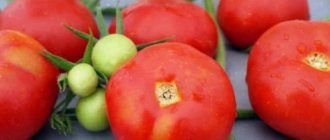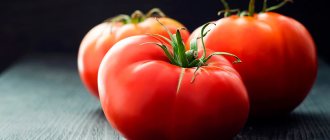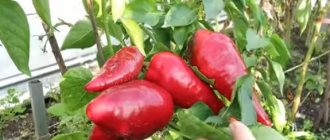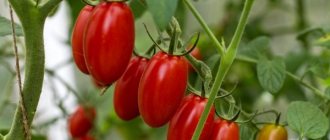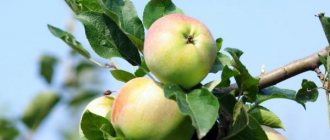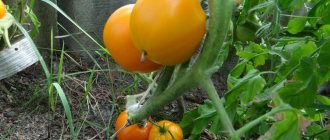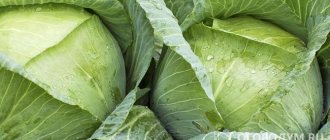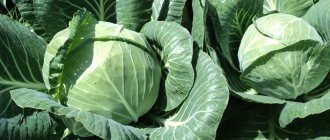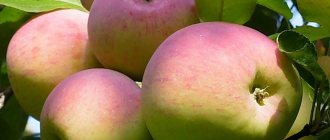The Perseus tomato has long been known to gardeners in our and neighboring countries. It can be grown in open ground, the bushes are powerful, strong and hardy, and the fruits have universal uses and excellent taste.
| Height | Landing location | Ripening time | Fruit color | Fruit size | Origin | Fruit shape |
| short | Open ground | Mid-early | Reds | Average | Variety | Round |
Tomatoes Perseus: variety description
| Variety name | Perseus |
| general description | Mid-season determinate variety |
| Originator | Moldova |
| Ripening period | 108-115 days |
| Form | Round, slightly flattened |
| Color | Red |
| Average weight of tomatoes | 110-180 grams |
| Application | Fresh, for preservation |
| Productivity of the variety | 6-8 kg per sq.m |
| Features of cultivation | Standard agricultural technology |
| Disease resistance | Resistant to many diseases |
The Perseus tomato variety belongs to the determinate mid-early varieties.
Its homeland is Moldova, it was bred at the end of the 19th century. The height of the bushes of this plant usually reaches fifty to sixty centimeters; they do not form a standard. The bushes are characterized by good foliage, and their first inflorescence is usually located above the sixth or seventh leaf. Perseus tomatoes are resistant to fusarium, alternaria, anthracnose and tobacco mosaic virus. They can be grown in open ground and in greenhouses.
Description of the fruit
- The fruits of this type of tomato have a flat-round shape.
- The weight of one fruit is from one hundred ten to one hundred eighty grams.
- They are covered with a dense red peel, and have a small green spot near the stalk.
- The fruits have a pleasant taste and good commercial quality.
- Transportation is well tolerated. These tomatoes are stored for a long time, so they can be transported over long distances.
- The number of chambers in these fruits ranges from five to seven, and the dry matter content is quite low.
The fruits of these tomatoes can be eaten fresh or canned.
You can compare the weight of the fruits of the variety in the table below:
| Variety name | Fruit weight |
| Perseus | 110-180 grams |
| Monomakh's hat | 400-550 grams |
| Pink King | 300 grams |
| Black pear | 55-80 grams |
| Icicle Black | 80-100 grams |
| Moscow pear | 180-220 grams |
| Chocolate | 30-40 grams |
| Sugar Pudding | 500-600 grams |
| Zhigalo | 100-130 grams |
| Golden domes | 200-400 grams |
Requirements for seed material
Particular attention should be paid to the quality of the seeds that will be used to grow seedlings. Some people buy seeds in stores. The description of the Perseus tomato indicates that this is not a hybrid variety, therefore, it can be successfully grown as seedlings from seeds collected from your own plot. To do this, the healthiest bush is selected, on which the fruit of the most regular shape and large size is left. It is better if the fruit that is left for seed grows on the first ovary from the ground.
Ripe Perseus tomatoes, intended for collecting seeds from them, are laid out in one layer on a flat surface for final ripening. Then the seeds are selected from them, washed in water and placed on a sieve to drain the water.
The seeds are laid out on a sheet of paper to dry, and then placed in paper envelopes for storage. It is advisable to make an inscription on the bag about the variety and date of preparation. Tomato seeds that are stored for more than 5–6 years lose their viability.
Classification of medical clothing. What to look for when buying a medical suit || Types of medical clothing
Soil for sowing seeds can be purchased in specialized stores or prepared with your own hands. To do this, add compost and humus to the soil dug up in the garden.
It is advisable to take soil on which nightshade crops have not been planted for several years. To disinfect the soil, water it with a slightly pink solution of manganese.
Purchased soil has the following advantages over garden soil:
- There are no pathogens, including fungal ones, that usually affect plants.
- Much lighter than garden wood and less dense.
- Some soils are enriched with photobacteria, which have a protective function for seedlings.
- The soil from the package is balanced in nutrients.
- When using, there is no need to prepare it in advance and store it indoors for a long time.
- It is inexpensive and can be purchased in the required packaging.
They begin to sow seeds taking into account the fact that seedlings will have to be planted in open ground after 2 months. If seedlings are planted in greenhouses, you can plant the seeds 2 - 3 weeks earlier.
Characteristics
The main advantages of Perseus tomatoes can be called:
- Heat resistance.
- Transportability.
- Large fruit.
- Good taste of the fruit.
- Disease resistance.
This variety of tomatoes has virtually no disadvantages, which is why it is a favorite of many gardeners. The Perseus tomato variety has good yield. From six to eight kilograms of fruits are collected from one square meter of planting. From the emergence of seedlings to the ripening of the Perseus tomato fruit, it usually takes from one hundred eight to one hundred fifteen days. The fruits form quickly and ripen almost simultaneously.
You can compare the yield of this variety with others in the table:
| Variety name | Productivity |
| Perseus | 6-8 kg per square meter |
| Aurora f1 | 13-16 kg per square meter |
| Leopold | 3-4 kg per bush |
| Sanka | 15 kg per square meter |
| Argonaut f1 | 4.5 kg per bush |
| Kibitz | 3.5 kg per bush |
| Heavyweight of Siberia | 11-12 kg per square meter |
| Honey cream | 4 kg per square meter |
| Ob domes | 4-6 kg per bush |
| Marina Grove | 15-17 kg per square meter |
Care
To get a good harvest, it is necessary to care for the plants during the growing season. Basic care includes:
- Infrequent but abundant watering; on average, 2-3 liters of water should be poured onto one adult bush.
- Timely ridding of the area with tomatoes from weeds.
- Loosening the soil to allow air to reach plant roots.
- Periodic feeding: during the growth period - nitrogen-containing fertilizers, during the flowering period - spraying with magnesium and boron, during the fruiting period - potassium and phosphorus fertilizers.
- If necessary, treatment with fungicides and other drugs to prevent diseases.
Fertilizing tomatoes
You should not apply fertilizer often or in excess, as this can adversely affect not only the development of plants, but also human health.
As the fruits ripen, you need to pick them, which will promote the ripening of still green tomatoes.
Features of cultivation
Perseus tomatoes can be grown in almost any region of Russia, as well as in Moldova, Belarus and Ukraine. This heat-loving crop is usually grown in open ground by sowing or seedlings. To obtain seedlings, seeds should be sown between March 1 and March 10 in pots measuring ten by ten centimeters filled with a nutrient mixture.
After fifty-five to sixty days, the seedlings are planted in the garden. This usually happens in the second ten days of May. If you want to get an early harvest, plant the seedlings in the beds in early May and cover them with film until it gets warmer outside.
These tomatoes will grow best in loamy soil enriched with organic fertilizers. For planting, choose a sunny place, protected from strong winds. The distance between plants and between rows should be fifty centimeters.
Planting seedlings in the soil
Seeds are prepared for planting in several ways.
You can soak them in a growth stimulator. The sown seeds should be carefully looked after. Improper care can lead to drying out of the soil or the formation of mold due to excess moisture.
A description of planting seeds can begin with soaking them in a weak solution of manganese. After 2 hours, the liquid is drained and the container is left covered with a damp cloth so that the seeds hatch. When most of the seeds have sprouted, they are ready to sow. In a container with soil, grooves are made at a distance of 5 cm. The depth of planting the seeds is 1 - 1.5 cm. Then the planting is covered with soil and the soil is lightly compacted.
To reduce the process of evaporation of moisture from the soil, the container with the planted seeds is covered with film and placed in a warm room until germination. After this, the container with the seedlings is taken to a cooler place with a temperature of approximately 21 degrees.
Tomato seedlings, in addition to lighting 12 hours a day, require darkness the rest of the time, when the shoots release carbon dioxide and are saturated with useful substances.
Approximately 10–14 days after the appearance of the first shoots, the seedlings are picked. It is transplanted into another container. Can be transplanted into peat pots.
It is recommended to plant tomatoes in the soil after zucchini, cabbage and pumpkin. You should not plant tomatoes in the same place for more than two years in a row. When the ground warms up by more than 14 degrees at a depth of 15 cm, you can begin planting seedlings. This process usually begins in early June.
Humus and wood ash are added to the prepared holes, and then a peat pot with seedlings is placed. The upper part of the pot with seedlings is sunk 4–5 cm into the soil. This is especially necessary if the plant is too elongated.
Seed procurement is treated with special attention. You can buy them at the store or assemble them yourself. Tomato Perseus is not a hybrid variety. Therefore, it can be grown from seeds of past harvests. To do this, it is not enough to take a beautiful fruit and collect seeds from it. You need to know for sure that it was collected from a healthy bush.
Place the tomatoes destined for seeds in a warm place and wait until they become soft. Then the seeds are selected, washed in running water and placed on a sieve. Place them on paper or cloth so that they dry thoroughly (not in a pile). After a couple of days, they hide them in a paper bag, sign them and put them in storage.
The soil for sowing is also prepared in advance. You can also buy it ready-made in the store or prepare it yourself. To do this, add compost or humus to the soil taken from the garden. It is advisable to take it in an area where nightshades have not previously grown. Spill the prepared soil with a solution of potassium permanganate. Placed in storage until March.
Many gardeners believe that it is better to use special soil from the store. Its advantages:
- Does not contain pathogens, fungi and bacteria that can destroy seedlings.
- It is loose and has a much lower density than garden soil.
- Some types of soil contain phytobacterial spores that protect seedlings.
- Has a balanced set of nutrients.
- It does not need to be prepared in advance and stored in the apartment for several months.
- These mixtures are inexpensive, and it is possible to buy packaging of any weight.
Before sowing the seedlings, they are watered with Baikal in a ratio of 1:10. At the same time, the seeds begin to prepare. The time is calculated so that the plants live indoors for 2 months before being planted in open ground. For greenhouses this can be done 3 weeks earlier.
Seed preparation is carried out in various ways. One of them is soaking in a growth stimulator. You can put them on germination, but only if it is possible to control the germination process. Without supervision, seeds can dry out or become moldy from lack of air, or rot from excess moisture.
Preparation and sowing of seeds:
READ MORE: Crassula diseases, photos and effective treatment
After most of the plants have hatched from the soil, move the box to a sunny place, preferably a windowsill. The temperature there is several degrees lower than in the room. This will help the plants switch to self-feeding without any problems.
Insufficient lighting will cause plants to stretch out and become unviable. Their thickening will lead to the same result. Therefore, shoots that are too dense are thinned out, not sparing the discarded plants.
It is advisable to reduce the temperature to 15°C during the day and 6°C at night before the first true leaf appears. But not everyone wants to harden themselves with seedlings. You can take it out onto the loggia if it doesn’t freeze there. Then the temperature is raised again to room temperature, and taken out into the cold overnight. The seedlings are watered by spraying from a spray bottle. She does not like waterlogging and may get blackleg. Sick plants droop to the ground and dry out, although there is no visible damage to them.
There should be holes in the bottom to drain excess water. The earth is poured so that there is a couple of centimeters left to the top of the box. Before diving, water the plants and wait until the ground softens. When replanting, the roots of the plants should be shortened. They usually break off when being removed from a box of seedlings. If the root still remains long, it is shortened by a third.
Diving strengthens the root system. It begins to develop in breadth and becomes fibrous. Such plants tolerate planting in open ground well. If it is not possible to pick up the seedlings, cut the roots at a depth of 4 cm.
When the tomatoes grow to 20 cm, they are hilled up with fresh soil. If possible, plant plants in separate pots or bags. Water moderately so that the roots do not rot and the plant does not stretch. Tomatoes planted in garden soil are fed with complex fertilizers. When they reach a height of 25 cm and form 8 leaves and a lower inflorescence, they can be replanted.
Tomatoes are not planted in areas where nightshades and peppers have grown in the last 3 years. The best predecessors are carrots, onions, legumes, and cucumbers. It bears fruit well on loamy soil, into which rotted manure or compost is added. The area should be well lit by the sun and always ventilated. Do not plant in places where the air stagnates: near tall plants, solid hedges.
In the fall the area is dug up, and in the spring the moisture is covered by leveling it with a rake. Weeds that grow by the time the seedlings are planted are cut off using any of the available methods. Potassium and phosphorus mineral fertilizers are applied in the fall, nitrogen fertilizers in the spring. There is no need to rush with planting. Tomatoes are very afraid of spring frosts.
Rules for transplanting seedlings into the ground:
- Before planting, seedlings are watered abundantly so that they can be easily removed from the box.
- In the prepared area, they dig holes up to 20 cm deep.
- The distance between the bushes is 50-70 cm. If it is smaller, the bushes will merge, which contributes to the spread of diseases.
- In hot weather, seedlings are placed so that the root is at an angle. The plant will lie on the ground for a while, but will soon rise. But it will spend less effort on adaptation.
- Cover with soil and water. Up to 2 liters of water are poured under the bush.
- The area near the trunk is covered with humus or compost. It’s a good idea to cover the bush from the sun with a branch with foliage.
After the first clusters of fruits form on the bush, the lower leaves can be trimmed. This will facilitate the passage of air and protect the plants from fungal diseases. Tomato Perseus is a variety that does not require the formation of a bush.
During growth and ripening, the area in which the Perseus tomato grows is kept clean, removing weeds. Loosen the soil 2 times a month. If possible, water the plants. At least 8 liters of water are added per square meter. The fruits are picked as they ripen. You can remove unripe tomatoes and bring them to the desired ripeness in a bright place. This will promote the ripening of the remaining fruits.
Diseases and pests
Perseus tomatoes are highly resistant to many diseases. To protect the plants as much as possible, treat them with a solution of potassium permanganate five to six days after planting, and before flowering, carry out preventive spraying with fungicidal preparations.
Try growing Perseus tomatoes, and your family will enjoy delicious and healthy tomatoes all summer long.
| Mid-season | Mid-early | Late ripening |
| Anastasia | Budenovka | Premier |
| Raspberry wine | Mystery of nature | Grapefruit |
| Royal gift | Pink King | De Barao the Giant |
| Malachite Box | Cardinal | De Barao |
| Pink heart | Babushkino | Yusupovsky |
| Cypress | Lev Tolstoy | Altaic |
| Giant raspberry | Danko | Rocket |
If you find an error, please select a piece of text and press Ctrl+Enter.
Collecting seeds
To obtain seeds yourself, you need to choose fruits that best match the varietal qualities. The fruit must be ripe, but not overripe. It should be cut crosswise, then remove the seeds into a small cup. After collecting, the seeds must be kept in their own juice for a couple of days, during which time the juice will ferment and the seeds will sink to the bottom. Then rinse them well and dry at room temperature, laying them out on a sheet of paper and stirring occasionally. Store dried seeds in a cool, dry place in labeled paper bags.
Tomato Perseus is a wonderful high-yielding variety, proven by time and several generations of gardeners. It has many advantages and is easy to grow. With the right agricultural technology, you can get a large harvest of tomatoes.
